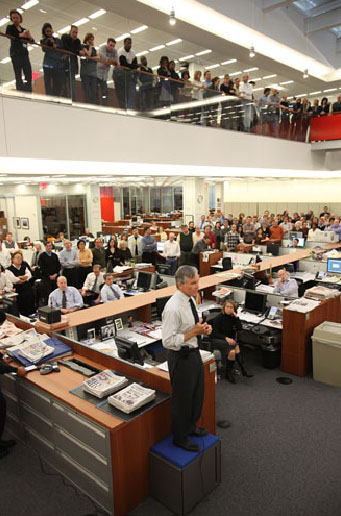By Hojung Deena Lee
UJW
ELLICOTT CITY, Md. — The sci-fi movie, I Am Legend, starring Oscar-winning actor Will Smith, might not be so unrealistic anymore. At least not at the offices of The Seattle Post-Intelligencer, the city’s oldest newspaper that ended its 146-year print history on March 17, but continues its online presence.
The offices overlook the tranquil, barren vista of the Puget Sound River, which also seems to pervade inside the offices of the Post-Intelligencer, where rows of empty desks fill the cavernous newsroom.

In I Am Legend, a plague kills most of humanity and only the survivors in New York are left to find a cure. At the Post-Intelligencer, Scott Gutierrez, 32, is one of the remaining 20 journalists out of 170. He feels like “the whole planet is wiped out” and he is “the last survivor trying to find the anti-virus.”
“I was excited to be in a big-city newsroom,” Gutierrez said. He said he liked it when lots of phones were ringing and editors and reporters were running around chasing news.
“It was this energy to it that I was happy to be a part of,” he said.
But those were the good old days. Print journalism has suffered tremendously over the years because of the popularity of the Internet and the recession, which has impacted newspapers’ bottom line.
The wave of recession has not only struck The Post-Intelligencer. EW Scripps Co.’s Rocky Mountain News shut down. The Boston Globe and The San Francisco Chronicle are on the brink of joining the list. This trend is occurring nationwide, and it seems that not even The New York Times is safe.
“Even though the Times has more resources than almost any other newspaper, no one is immune,” said Sophia Hollander, a contributing writer for the paper.
The debt-strapped newspaper is known for its skyscraper on the west side of Manhattan. The investment firm W.P. Carey & Co. LLC recently purchased 21 floors of the building, according to The Times.
Things have gotten worse. The Times offered buyouts so it could eliminate 100 newsroom jobs last year, Hollander said. It also reported another layoff of 100 employees on the business side on March 26. The newspaper plans to make more cuts by reducing freelancers to 10 percent from 15 percent of the staff and possibly merge some sections.
In addition, The Times is cutting the salaries of all employees by 5 percent for the rest of the year.
The recession also has had an impact on the business section of The Baltimore Sun, said Hanah Cho, a business journalist at the newspaper. Cho covers the personal struggle of people and the unemployed. She said The Baltimore Sun recently folded the business section into the A section of the paper.
“You just feel like now — more than ever — the business coverage is important because of the recession,” said Cho. “Eliminating the section is a blow to your work. We take a lot of pride in our section.”
The Baltimore Sun’s parent company, The Tribune Co., which owns The Los Angeles Times and The Chicago Tribune, filed for bankruptcy. The company is $13 billion in debt, the Tribune reported, and has been losing money for more than a decade.

The Baltimore Sun, famous for its international coverage, also has shut down all of the foreign bureaus in Africa, Moscow, Israel, Beijing and London in the pas t five years, Cho said. Additionally, the paper reported that suburban bureau employees moved to its main downtown office.
Last July, The Sun announced it would cut 20 percent of its staff, eliminating 100 jobs. The newspaper has already gone through four rounds of buyouts and layoffs since December 2005.
The newspaper casualty list also includes its hometown competitor. The Baltimore Examiner, a free daily tabloid, shut down in late January.
“Who is going to keep the government accountable?” said Laura McCandlish, a former Sun journalist, now freelancing for The Oregonian. “(Journalists) are very scared about their careers. There is no job security.”
As a result, McCandlish said, some journalists have left the business t o go into public relations. Others have gone back to school.
Cho said that many journalists have given up the business altogether. She said she tries not to even talk about it with the remaining workers at the paper.
“Why are we still doing this? Cho asks herself. “We can do something else for more pay, less stress and more appreciation of our work.”
Although the situation might be discouraging, Cho tries to keep her morale up. She plans to attend a journalist-training center, hoping to learn more about multimedia skills.
“I know it is sort of cliché, but it is a rollercoaster ride,” she said. “You are here and there, in terms of emotions. But then, here and there you’re reminded of why you’re a journalist.”
While some blame the recession, others think there’s another reason for the decline in print journalism.
“The Internet is a more dangerous force (than the recession) because it is going to require a fundamental rethinking or restructuring of how newspapers function and how they make money,” said Sophia Hollander, The New York Times contributing writer.
While Gutierrez doesn’t disagree, he thinks there still is a demand for print journalism.
“People still want to cut out copies of articles,” he said.
He added that when former Illinois Sen. Barack Obama was elected president, people still wanted to hold on to the old, dusty copy of the newspaper that depicted the historic moment. A photo from the Internet is “not as authentic as print journalism,” Gutierrez said.
Still, Gutierrez and other journalists see light at the end of the tunnel.
Joel Connelly, a Post-Intelligencer columnist, who worked for the paper for more than 33 years, said, “The PI has to show the country that online journalism can be possible and can be a quality product.”
The New York Times also strives to adapt to the reality that newspapers might be going away. It recently announced a cooperative venture with the International Herald Tribune, the global edition of the Times, to spice up its Web site for more local and international appeal. It also launched a crossword application for iPhone and iPod users.
Like the Times, The Tribune Co. is making moves by recently announcing the creation of an online entertainment news bureau that provides multimedia content.
Tasnim Shamma, a Princeton journalism student, is preparing herself for the new skills required of journalists.
“I am confident that I will be able to make my way as a journalist,” said Shamma. “I have been training myself in various new forms of journalism, such as knowing how to blog and make videos, which are important for any journalist to learn or to survive these days.
“The Internet has changed and people get news 24/7,” she added. “So that changes the job of the journalist.”
“There is not a lot of work,” Post-Intelligencer reporter Gutierrez said. Since the PI’s print demise, he writes quicker, blogs more, but does less in-depth reporting.
“You are just always trying to get information as quickly as you can and post the articles as correctly and accurately as you can,” he said.
Clearly, the Internet is affecting print journalism — both positively and negatively — but how it will play out in the future is anyone’s guess.
“I think traditional newspapers have expanded their reach through Web sites and blogs,” former Baltimore Sun staffer Laura McCandlish said. “But they haven’t figured out how to make money from the Web sites.”


